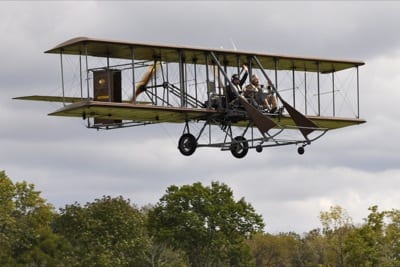
Dayton’s aviation heritage will take center stage in Texas March 2 when two Wright “B” Flyer lookalike aircraft take part in a celebration at Fort Sam Houston in San Antonio.
The two airplanes were being prepared to begin their journey Feb. 23 – by road, loaded on tractor-trailers. Thirteen Wright “B” Flyer Inc. volunteers will follow on Feb. 26 to unload, assemble, test and operate the one-of-a-kind flying machines to help San Antonio observe a milestone in military aviation. It was 100 years ago March 2 when Army Lt. Benjamin Foulois made the first military solo flight from a military airfield – Fort Sam Houston’s parade field. The airplane he flew, Army Signal Corps No. 1, was a 1909 Wright Flyer, built in Dayton by the Wright brothers.
The deployment is a massive undertaking for the all-volunteer, nonprofit aviation heritage organization, which has flown or displayed lookalikes of Wright airplanes at major events across the United States and abroad.
“It’s the first time we’ve deployed two airplanes” simultaneously to an out-of-town event, said Mitchell “Mitch” Cary, Wright “B” Flyer Inc.’s president and chief pilot. “This probably is the largest crew we’ve put on the road, out of necessity.”
It isn’t the group’s first visit to San Antonio. Cary said volunteers took a flyer there in 1987 to help celebrate the 70th anniversary of Brooks Air Force Base.
A San Antonio-based chapter of the Order of the Daedalians, a fraternal organization of military pilots, requested Wright “B” Flyer’s participation in the March 2 event and is underwriting the cost with private donations.
“The year 2010 has been declared the Centennial of Military Aviation in Texas with activities all year long. The big kick-off for the whole program will be the Foulois Centennial,” said Bill Stewart, heritage officer for Order of the Daedalians Stinson Flight No. 2 and a retired Air Force colonel.
The program will feature a re-enactment of the original event using Wright “B” Flyer’s “wonderfully similar aircraft,” said Stewart.
To accomplish this safely, Wright “B” Flyer will use two airplanes.
Its “Brown Bird,” (pictured) a modern airplane built to look like a Wright Model B Flyer, will be flown from nearby Stinson Municipal Airport for flybys during the ceremony. On the parade field below, volunteers dressed in period Signal Corps uniforms will taxi the “Yellow Bird,” a close replica of a Wright Model B that is used for ground displays. Neither airplane looks exactly like the Wright machine Foulois took to Texas. “We’re the closest thing to a 1909 Flyer that’s available,” Cary said.
Army Signal Corps No. 1 originally had front-mounted elevators called “canards” and skids with no wheels – hallmarks of the early Wright flyers. The Wrights introduced the Model B in 1910; it featured a tail-mounted elevator, wheels under the skids, and other changes. Over the same year, Foulois made similar modifications to Signal Corps No. 1. “By the end of the year, the plane Foulois was flying became a ‘B,’ ” Cary said.
Foulois’ first flight is historic in more ways than one. He’d had just 54 minutes of instruction from Wilbur Wright at College Park, Md., when Brig. Gen. James Allen, chief of the Signal Corps, dispatched him and the airplane to Fort Sam Houston with orders to “teach yourself to fly,” according to Foulois’ memoir, “From the Wright Brothers to the Astronauts.”
Foulois wrote that he exchanged letters with the Wright brothers, who offered tips on controlling the machine. That correspondence “later led him to describe himself as the first pilot who had ever learned to fly by mail,” said Tom Crouch, senior curator of aeronautics for the Smithsonian Institution in Washington, D.C., where Signal Corps No. 1 is on display in its original configuration.
Foulois helped shape American air power in a career that included serving as chief of the Army Air Corps’ Materiel Division at Wright Field (now Wright-Patterson Air Force) near Dayton, from June 1929 to July 1930. He retired as a major general in 1935 and died in 1967.
“Benjamin Foulois’ first flight is being replicated in perfect form: a memorable flight in San Antonio with a plane made in Dayton,” said Tony Sculimbrene, executive director of the National Aviation Heritage Alliance in Dayton, which includes Wright “B” Flyer Inc. “One hundred years later, the situation remains the same, with pilot training the focus of the Air Force’s Air Education and Training Command, based in San Antonio, and the development of the latest ‘flying machines’ coming from Air Force Material Command at Wright-Patterson.”
Wright “B” Flyer Inc. is an all-volunteer, not-for-profit corporation that promotes Dayton’s aviation heritage by flying and displaying lookalikes of Wright Model B airplanes. It is based on Dayton-Wright Brothers Airport in Ohio, where its hangar-museum is open to the public at no charge from 9 a.m. to 2:30 p.m. on Tuesdays, Thursdays and Saturdays. For more information: Wright-B-Flyer.org.
